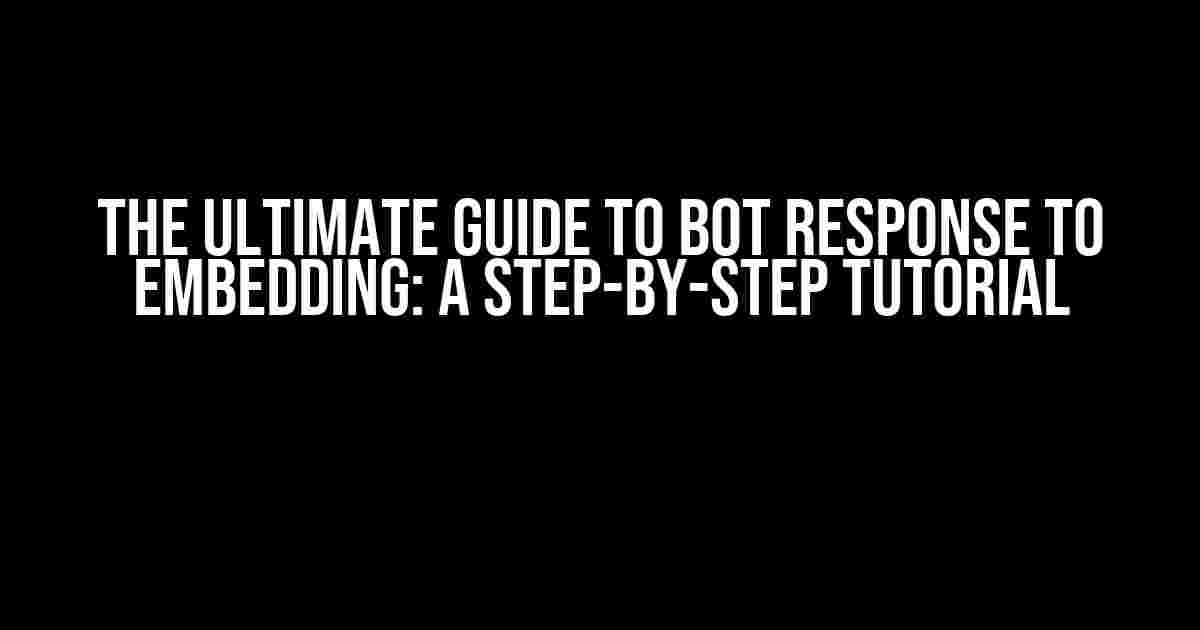Welcome to the world of conversational AI! In this article, we’ll delve into the fascinating realm of bot response to embedding, a crucial aspect of natural language processing (NLP). By the end of this comprehensive guide, you’ll be equipped with the knowledge and skills to create intelligent bots that can understand and respond to user inputs like a pro.
What is Bot Response to Embedding?
Before we dive into the nitty-gritty, let’s define what bot response to embedding means. In simple terms, it’s the ability of a chatbot or conversational AI to comprehend and respond to user input, which is often represented as a vector or embedding in machine learning models.
Think of it like this: when a user types a message to a chatbot, the AI needs to process that input and generate a relevant response. This process involves converting the user input into a numerical representation, called an embedding, which the bot can understand and respond to accordingly.
Why is Bot Response to Embedding Important?
Bot response to embedding is crucial for several reasons:
- Improved User Experience: By accurately understanding user inputs, bots can provide more relevant and helpful responses, leading to increased user satisfaction and engagement.
- Enhanced AI Capabilities: Embedding responses enable bots to learn from user interactions and adapt to new scenarios, making them more intelligent and efficient over time.
- Increased Efficiency: Automating tasks and providing accurate responses reduce the workload for human customer support agents, freeing them up to focus on more complex issues.
Step-by-Step Guide to Bot Response to Embedding
Now that we’ve covered the what and why, let’s dive into the how. Follow these steps to create a bot that can respond to user inputs via embedding:
Step 1: Choose a Programming Language and Framework
Select a programming language and framework that supports NLP and machine learning. Popular choices include Python with TensorFlow or PyTorch, Java with Weka, or Node.js with Brain.js.
import tensorflow as tf
from tensorflow.keras.preprocessing.text import Tokenizer
from tensorflow.keras.preprocessing.sequence import pad_sequences
Step 2: Prepare Your Data
Gather a dataset of user inputs and corresponding responses. This can be in the form of a CSV file, JSON data, or even a database.
| User Input | Response |
|---|---|
| Hello! | Hi! How can I help you today? |
| What’s the weather like? | The current weather is sunny with a high of 75°F. |
| Book a flight to New York. | I’d be happy to help! Can you please provide your travel dates and preferred airline? |
Step 3: Preprocess Your Data
Preprocess your dataset by tokenizing the user inputs, removing stop words, and converting the text data into numerical embeddings.
tokenizer = Tokenizer(num_words=5000)
tokenizer.fit_on_texts(user_inputs)
tokenized_inputs = tokenizer.texts_to_sequences(user_inputs)
padded_inputs = pad_sequences(tokenized_inputs, maxlen=50)
Step 4: Train Your Model
Train a machine learning model using your preprocessed data. You can use a simple neural network or a more complex architecture like a transformer.
model = tf.keras.models.Sequential([
tf.keras.layers.Embedding(input_dim=5000, output_dim=128, input_length=50),
tf.keras.layers.Flatten(),
tf.keras.layers.Dense(64, activation='relu'),
tf.keras.layers.Dropout(0.2),
tf.keras.layers.Dense(64, activation='softmax')
])
model.compile(optimizer='adam', loss='categorical_crossentropy', metrics=['accuracy'])
model.fit(padded_inputs, responses, epochs=10)
Step 5: Integrate with Your Bot
Integrate your trained model with your chatbot or conversational AI platform. When a user inputs a message, use the model to generate a response.
def respond_to_user_input(user_input):
tokenized_input = tokenizer.texts_to_sequences([user_input])
padded_input = pad_sequences(tokenized_input, maxlen=50)
response = model.predict(padded_input)
return response
Common Challenges and Solutions
While implementing bot response to embedding, you might encounter some common challenges. Here are some solutions to get you back on track:
Challenge 1: Handling Out-of-Vocabulary (OOV) Words
Solution: Use a tokenizer that can handle OOV words or implement a custom solution using techniques like subwording or character-level modeling.
Challenge 2: Dealing with Ambiguity and Context
Solution: Implement contextual understanding using techniques like named entity recognition, part-of-speech tagging, or dependency parsing.
Challenge 3: Balancing Accuracy and Efficiency
Solution: Optimize your model using techniques like pruning, quantization, or knowledge distillation to achieve a balance between accuracy and efficiency.
Conclusion
And that’s it! With this comprehensive guide, you should now be equipped to create a bot that can respond to user inputs via embedding. Remember to stay up-to-date with the latest advancements in NLP and machine learning to continually improve your bot’s capabilities.
Additional Resources
Looking for more resources to take your bot to the next level? Check out these links:
- TensorFlow Text Classification Tutorial
- PyTorch NLP Tutorial
- NLP Progress: State-of-the-Art Models and Datasets
Happy building!
Frequently Asked Questions
Get the inside scoop on how bots respond to embedding!
What is bot response to embedding?
A bot’s response to embedding refers to how it processes and responds to embedded content, such as images, videos, or audio files, within a conversation or message. This response can include generating a caption, providing additional information, or even initiating a new conversation topic.
How do bots handle multimedia embeddings?
Bots can be trained to handle multimedia embeddings in various ways, such as extracting metadata, generating descriptive text, or even using computer vision to analyze visual content. This allows the bot to provide more meaningful and engaging responses to users.
Can bots respond differently to different types of embeddings?
Absolutely! Bots can be programmed to respond differently to various types of embeddings, such as responding to images with descriptive text or responding to videos with a summary of the content. This allows the bot to tailor its response to the specific type of embedded content.
How can bots improve their response to embeddings?
Bots can improve their response to embeddings by leveraging machine learning algorithms, increasing their training data, and fine-tuning their natural language processing abilities. This enables the bot to better understand the context and meaning behind embedded content and provide more accurate and helpful responses.
What are the benefits of using bots with embedding capabilities?
The benefits of using bots with embedding capabilities include enhanced user engagement, improved conversational flow, and increased accuracy in responding to user queries. This can lead to higher user satisfaction and a more personalized experience.

